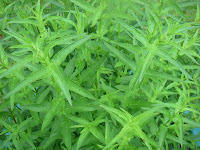 |
| Galerucella Leaf-feeding Beetle |
In preparation for this project White Memorial has been growing several potted loosestrife plants. When we noticed the beetles starting to breed, we went out to capture them. In order to get an even ratio of male to female beetles we tried capturing beetles that were in the process of breeding. Then every ten beetles that were caught were placed into a holding jar. On our first try of Catlin Marsh we were able to capture approximately 70 beetles. We brought the beetles back to the museum, and each vessel of ten beetles were released onto a potted loosestrife plant, which was then canopied with a light fabric covering. The beetles will remain on the plant for about a month and a half or until they lay eggs and the larvae begin to emerge. Once the first new adults start to emerge it is time to take the pots to a wetland that is infested with purple loosestrife. At the wetland the fabric covering will be removed from the plant and the beetles will be released. Released adults feed on leaves for a few weeks, but disappear around mid-August to overwinter in the soil near their host plant. Galerucella leaf-feeding beetles were introduced to Connecticut in 1996; they primarily feed on purple loosestrife. If purple loosestrife is left unchecked, it can become a serious issue because the plant’s rapid growth can crowd out native species, therefore reducing biological diversity.
 |
| Purple Loosestrife (Lythrum salicaria) |
 |
| The potted loosestrife covered with fabric after the beetles were added. |

1 comment:
Excellent report Erin! Thank you for explaining how the the project will work-- looking forward to seeing how Galerucella leaf-feeding beetles eliminate the purple loosestrife population, eventually:-).
Post a Comment